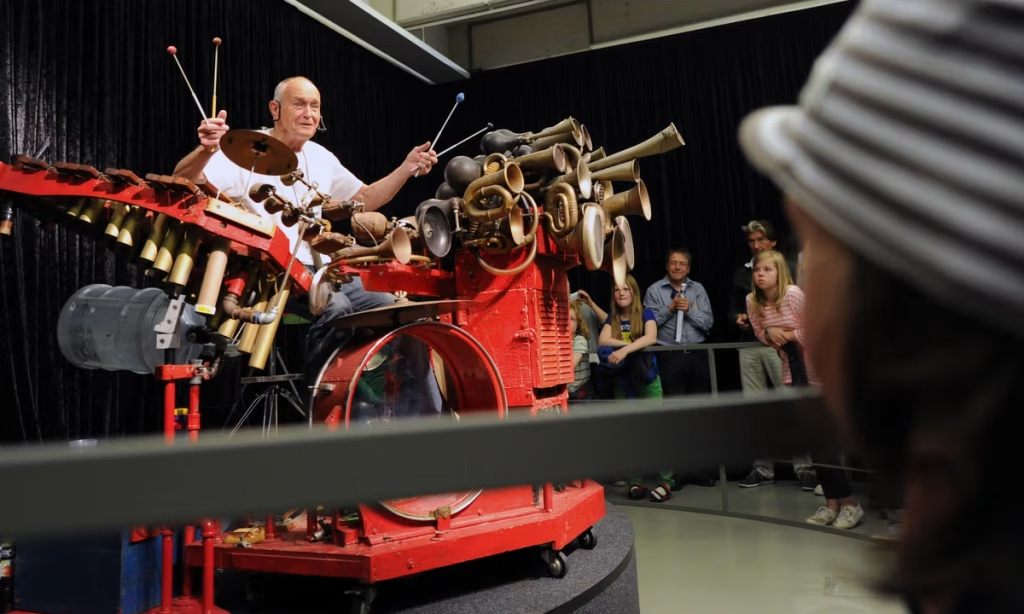The iconoclastic Los Angeles artist Llyn Foulkes died on 21 November at age 91. A Renaissance man who resisted the rote taxonomy of genre, Foulkes was a painter, jazz musician, filmic muse and art world troublemaker, bucking the commercial commodification of his practice throughout his long career. His varied, anarchic practice, which he termed “consistently inconsistent”, did not always endear him to the art establishment, but his trailblazing legacy sets him apart as a paragon of originality. Kent Fine Art, a gallery in New York that had published several books of Foulkes’s work, announced his death in a newsletter.
Foulkes was born in 1934 in Yakima, Washington. He studied art and music at the Central Washington College of Education in Ellensburg until he was drafted into the US Army in 1954. After serving two years in Germany, he relocated to Los Angeles in 1957 to attend the Chouinard Art Institute, an art school best known for its long-standing relationship with Walt and Roy Disney and considered an incubator of animators.
As a student at Chouinard, Foulkes began exhibiting with the influential Ferus Gallery and, in 1962, had his first institutional solo show at the Pasadena Art Museum (now the Norton Simon Museum). His early work flirted with the outside edges of the Pop Art movement, incorporating the iconography of postcards, vintage landscape photography and Route 66-inspired signage as a means to explore the failed promises of the Hollywood machine. In 1964, the Los Angeles County Museum of Art, then still under construction, was the first institution to acquire his work for its permanent collection. Ten years later, he was the subject of his first career retrospective at the Newport Harbor Art Museum (now the UC Irvine Langson Orange County Museum of Art).
The 1970s also marked a period of musical experimentation for Foulkes. He played drums in a band called City Lights from 1965 to 1971, and founded his own project, the Rubber Band, in 1973. He also performed solo as “The Machine”, a one-man protest of America’s imperial overreach and corporate politics that he played on a large homemade contraption made of horns, percussive and xylophone elements. In 2004, he released an album of original songs called Llyn Foulkes and His Machine: Live at the Church of Art.
Following the receipt of a major award for painting at the 1967 Paris Biennial and a 1977 Guggenheim Fellowship, Foulkes became concerned that his paintings were too formulaic and easily accessible, shifting his work into more explicitly political territory. In the 1980s, Foulkes began to incorporate fabric tableaux into his images and often included the figure of Mickey Mouse, a recurring symbol for corporate cultural conditioning. In one of his most famous pieces, POP (1985-90), Foulkes depicts himself as a father hypnotised by a television set while his son reads the pledge of the Mickey Mouse Club. In 1995’s I Thought Art Was Special (Mickey and Me), the mouse appears as a tumor on the artist’s brain.
Foulkes received the American Academy of Arts and Letters Award in 2008 and the Artists’ Legacy Foundation Award the following year. Beginning in 2013, he was the subject of a large-scale traveling exhibition that originated at the Hammer Museum in Los Angeles then was presented at the New Museum in New York and the Museum Kurhaus Kleve in Germany. In 2011 he participated in the Venice Biennale and the following year was featured in Documenta in Kassel, Germany. Last year, the New York gallery A Hug From The Art World mounted a survey of his work, spanning never-before-seen cartoons from his teenage years to more recent works made in protest of the war in Ukraine.
Two of Foulkes’s largest and most ambitious works, The Lost Frontier (1997-2004) and Deliverance (2004-07), are featured in a documentary about the artist, Llyn Foulkes One Man Band (2013), directed by Tamar Halpern and Chris Quilty. The documentary includes, among other interviewees, the late actor and photographer Dennis Hopper, and portrays Foulkes as a “lovable, cranky, and brilliant outsider” according to The New York Times.
